ECO mode HONDA ACCORD SEDAN 2001 Owner's Manual (in English)
[x] Cancel search | Manufacturer: HONDA, Model Year: 2001, Model line: ACCORD SEDAN, Model: HONDA ACCORD SEDAN 2001Pages: 372, PDF Size: 6.1 MB
Page 9 of 372
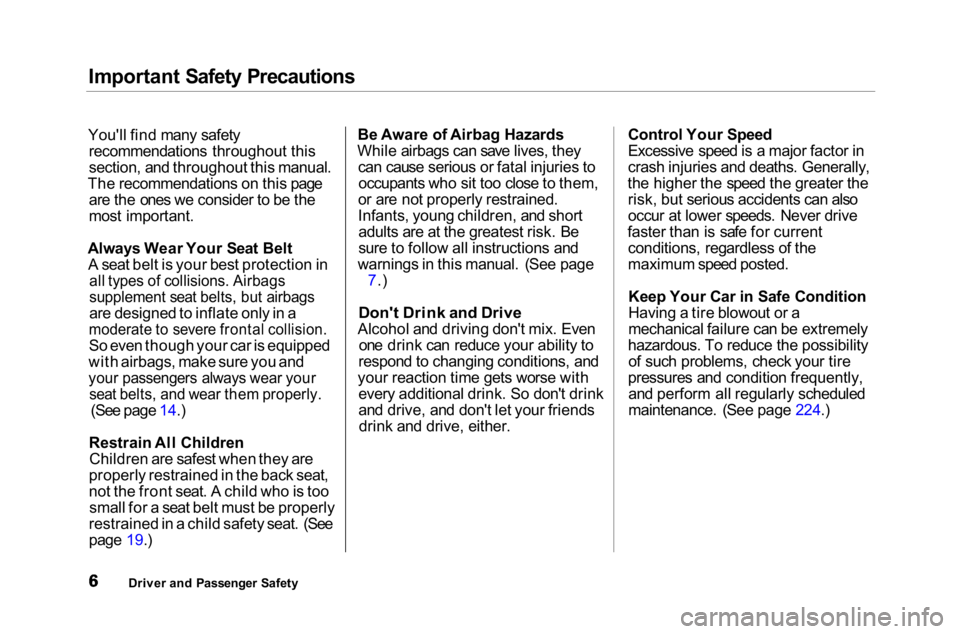
Important Safety Precautions
You'll find many safety recommendations throughout this
section, and throughout this manual.
The recommendations on this page are the ones we consider to be the
most important.
Always Wear Your Seat Belt A seat belt is your best protection in
all types of collisions. Airbags
supplement seat belts, but airbags
are designed to inflate only in a
moderate to severe frontal collision.
So even though your car is equipped
with airbags, make sure you and
your passengers always wear your
seat belts, and wear them properly.
(See page 14.)
Restrain All Children Children are safest when they are
properly restrained in the back seat,
not the front seat. A child who is too small for a seat belt must be properly
restrained in a child safety seat. (See
page 19.) Be Aware of Airbag Hazards
While airbags can save lives, they can cause serious or fatal injuries tooccupants who sit too close to them,
or are not properly restrained.
Infants, young children, and short adults are at the greatest risk. Be
sure to follow all instructions and
warnings in this manual. (See page 7.)
Don't Drink and Drive
Alcohol and driving don't mix. Even one drink can reduce your ability to
respond to changing conditions, and
your reaction time gets worse with every additional drink. So don't drink
and drive, and don't let your friendsdrink and drive, either. Control Your Speed
Excessive speed is a major factor in
crash injuries and deaths. Generally,
the higher the speed the greater the risk, but serious accidents can also
occur at lower speeds. Never drive
faster than is safe for current conditions, regardless of the
maximum speed posted.
Keep Your Car in Safe Condition
Having a tire blowout or a
mechanical failure can be extremely
hazardous. To reduce the possibility of such problems, check your tire
pressures and condition frequently, and perform all regularly scheduled
maintenance. (See page 224.)
Driver and Passenger Safety
Page 23 of 372
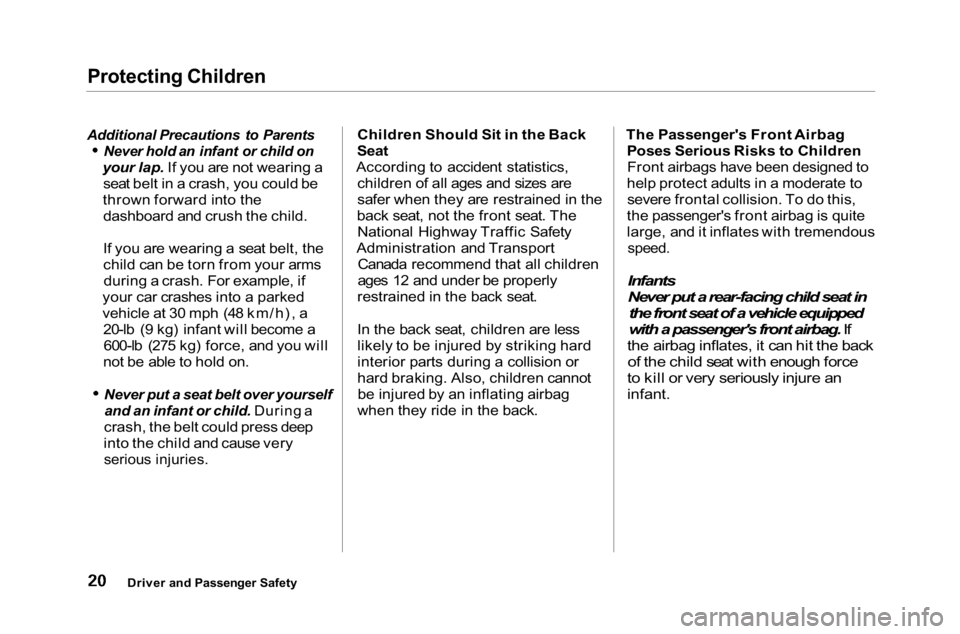
Protecting Children
Additional Precautions to Parents Never hold an infant or child on
your lap. If you are not wearing a seat belt in a crash, you could be
thrown forward into the dashboard and crush the child.
If you are wearing a seat belt, the
child can be torn from your armsduring a crash. For example, if
your car crashes into a parked
vehicle at 30 mph (48 km/h), a 20-lb (9 kg) infant will become a600-lb (275 kg) force, and you will
not be able to hold on.
Never put a seat belt over yourself
and an infant or child. During a
crash, the belt could press deep
into the child and cause very
serious injuries.
Children Should Sit in the Back
Seat
According to accident statistics, children of all ages and sizes are
safer when they are restrained in the
back seat, not the front seat. The National Highway Traffic Safety
Administration and Transport Canada recommend that all children
ages 12 and under be properly
restrained in the back seat.
In the back seat, children are less
likely to be injured by striking hard
interior parts during a collision or
hard braking. Also, children cannot be injured by an inflating airbag
when they ride in the back. The Passenger's Front Airbag
Poses Serious Risks to ChildrenFront airbags have been designed to
help protect adults in a moderate to severe frontal collision. To do this,
the passenger's front airbag is quite
large, and it inflates with tremendous
speed.
Infants
Never put a rear-facing child seat inthe front seat of a vehicle equipped
with a passenger's front airbag.
If
the airbag inflates, it can hit the back
of the child seat with enough force
to kill or very seriously injure an
infant.
Driver and Passenger Safety
Page 28 of 372
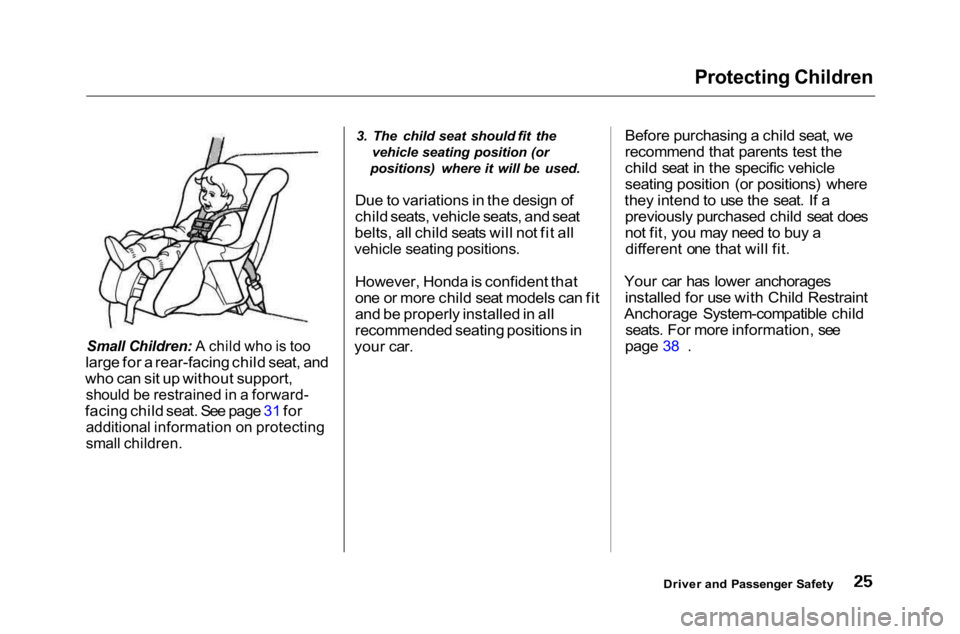
Protecting Children
Small Children: A child who is too
large for a rear-facing child seat, and
who can sit up without support,
should be restrained in a forward-
facing child seat. See page 31 for
additional information on protecting
small children.
3. The child seat should fit the
vehicle seating position (or
positions) where it will be used.
Due to variations in the design of
child seats, vehicle seats, and seat
belts, all child seats will not fit all
vehicle seating positions.
However, Honda is confident that
one or more child seat models can fit
and be properly installed in all
recommended seating positions in
your car. Before purchasing a child seat, we
recommend that parents test the
child seat in the specific vehicle
seating position (or positions) where
they intend to use the seat. If a previously purchased child seat does
not fit, you may need to buy adifferent one that will fit.
Your car has lower anchorages installed for use with Child Restraint
Anchorage System-compatible child seats. For more information, see
page 38 .
Driver and Passenger Safety
Page 31 of 372
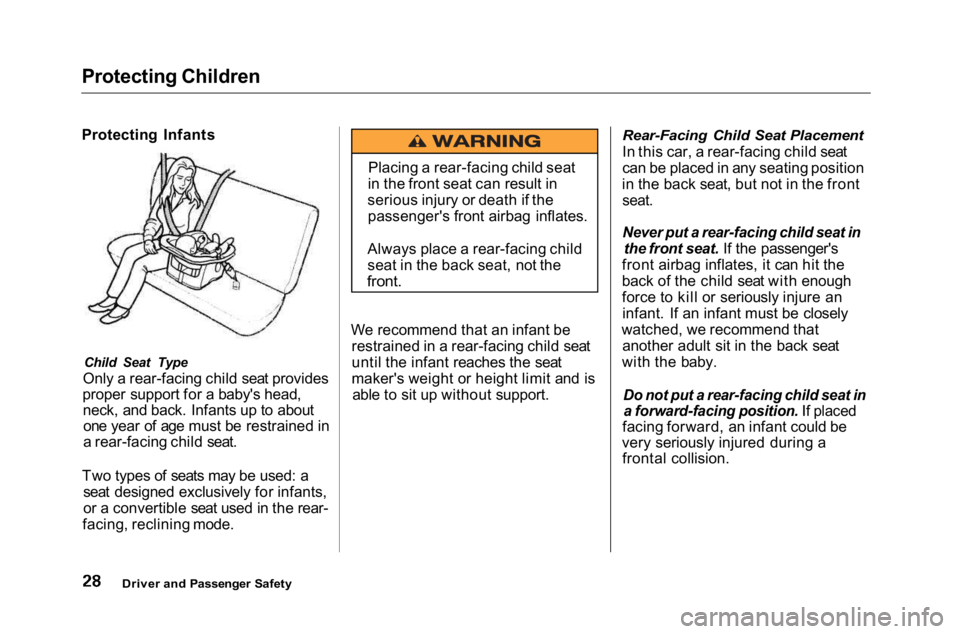
Protecting Children
Protecting Infants
Child Seat Type
Only a rear-facing child seat provides
proper support for a baby's head, neck, and back. Infants up to aboutone year of age must be restrained in
a rear-facing child seat.
Two types of seats may be used: a seat designed exclusively for infants,
or a convertible seat used in the rear-
facing, reclining mode. We recommend that an infant be
restrained in a rear-facing child seat
until the infant reaches the seat
maker's weight or height limit and isable to sit up without support.
Rear-Facing Child Seat Placement
In this car, a rear-facing child seat
can be placed in any seating position
in the back seat, but not in the front
seat.
Never put a rear-facing child seat in
the front seat. If the passenger's
front airbag inflates, it can hit the
back of the child seat with enough
force to kill or seriously injure an infant. If an infant must be closely
watched, we recommend that another adult sit in the back seat
with the baby.
Do not put a rear-facing child seat in
a forward-facing position. If placed
facing forward, an infant could be
very seriously injured during a frontal collision.
Driver and Passenger Safety
Placing a rear-facing child seat
in the front seat can result in
serious injury or death if the passenger's front airbag inflates.
Always place a rear-facing child
seat in the back seat, not the
front.
Page 46 of 372

Additional Information About Your Airbags
SRS Components
Your Supplemental Restraint System (SRS) includes:
Two front airbags. The driver'sairbag is stored in the center of
the steering wheel; the front
passenger's airbag is stored in the dashboard. Both are marked "SRS
AIRBAG."
Automatic seat belt tensioners
(see page 41).
Sensors that can detect a
moderate to severe frontal
collision.
A sophisticated electronic system
that continually monitors andrecords information about thesensors, the control unit, the
airbag activators, and driver and
passenger seat belt use when the ignition is ON (II).
An indicator light on the instrument panel that alerts you toa possible problem with the
system (see page 44).
Emergency backup power in case
your car's electrical system is
disconnected in a crash.
How Your Front Airbags Work
If you ever have a moderate to
severe frontal collision, the sensors
will detect the vehicle's rapid deceleration. If the rate of
deceleration is high enough, the
control unit will instantly inflate the
front airbags.
CONTINUED
Driver and Passenger Safety
Page 53 of 372

Safety Labels
These labels are in the locations shown. They warn you of potential
hazards that could cause serious
injury. Read these labels carefully.
If a label comes off or becomes hard
to read, contact your Honda dealer
for a replacement.
Driver and Passenger Safety
DASH BOARD
SUN VISOR
U.S. models
RADIATOR CAP
HOOD
Canadian models
U.S. models only
Page 58 of 372
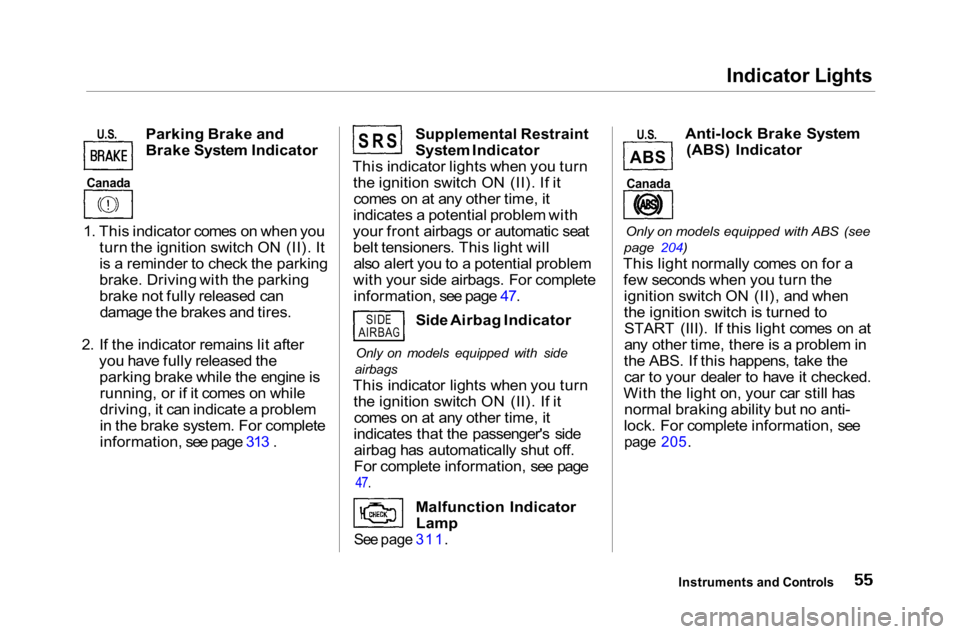
Indicator Lights
U.S.
Parking Brake and
Brake System Indicator
1. This indicator comes on when you turn the ignition switch ON (II). It
is a reminder to check the parking
brake. Driving with the parking
brake not fully released candamage the brakes and tires.
2. If the indicator remains lit after you have fully released theparking brake while the engine isrunning, or if it comes on while
driving, it can indicate a problem
in the brake system. For complete
information, see page 313 .
Supplemental Restraint
System Indicator
This indicator lights when you turn the ignition switch ON (II). If itcomes on at any other time, it
indicates a potential problem with
your front airbags or automatic seat belt tensioners. This light willalso alert you to a potential problem
with your side airbags. For complete information, see page 47.
Side Airbag Indicator
Only on models equipped with side
airbags
This indicator lights when you turn the ignition switch ON (II). If itcomes on at any other time, it
indicates that the passenger's side airbag has automatically shut off.
For complete information, see page
47.
Malfunction IndicatorLamp
See page 311.
U.S.
Anti-lock Brake System
(ABS) Indicator
Only on models equipped with ABS (see
page 204)
This light normally comes on for a few seconds when you turn theignition switch ON (II), and when
the ignition switch is turned toSTART (III). If this light comes on at
any other time, there is a problem in
the ABS. If this happens, take the car to your dealer to have it checked.
With the light on, your car still has normal braking ability but no anti-
lock. For complete information, see
page 205.
Instruments and Controls
Canada
S R S
SIDEAIRBAG
A B S
Canada
Page 59 of 372
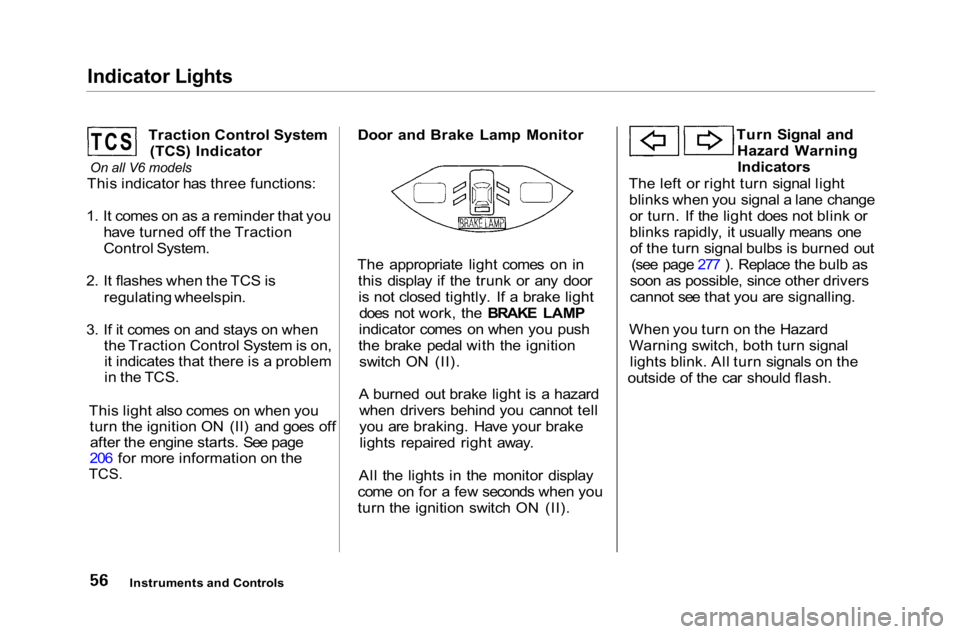
Indicator Lights
Traction Control System(TCS) Indicator
On all V6 models
This indicator has three functions:
1. It comes on as a reminder that you have turned off the Traction
Control System.
2. It flashes when the TCS is regulating wheelspin.
3. If it comes on and stays on when the Traction Control System is on,it indicates that there is a problem
in the TCS.
This light also comes on when you turn the ignition ON (II) and goes offafter the engine starts. See page
206 for more information on the
TCS.
Door and Brake Lamp Monitor
The appropriate light comes on in this display if the trunk or any dooris not closed tightly. If a brake light does not work, the BRAKE LAMP
indicator comes on when you push
the brake pedal with the ignition switch ON (II).
A burned out brake light is a hazard when drivers behind you cannot tell
you are braking. Have your brakelights repaired right away.
All the lights in the monitor display
come on for a few seconds when you
turn the ignition switch ON (II). Turn Signal and
Hazard WarningIndicators
The left or right turn signal light blinks when you signal a lane changeor turn. If the light does not blink or
blinks rapidly, it usually means oneof the turn signal bulbs is burned out (see page 277 ). Replace the bulb as
soon as possible, since other drivers
cannot see that you are signalling.
When you turn on the Hazard
Warning switch, both turn signal lights blink. All turn signals on the
outside of the car should flash.
Instruments and Controls
TCS
Page 60 of 372
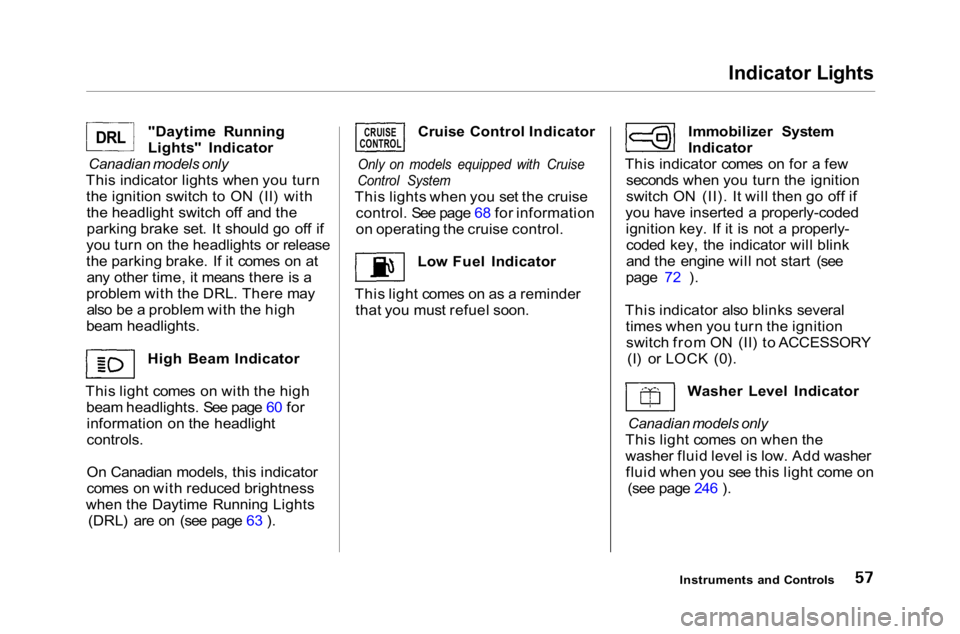
Indicator Lights
"Daytime Running
Lights" Indicator
Canadian models only
This indicator lights when you turn the ignition switch to ON (II) withthe headlight switch off and the
parking brake set. It should go off if
you turn on the headlights or release
the parking brake. If it comes on at any other time, it means there is a
problem with the DRL. There may also be a problem with the high
beam headlights.
High Beam Indicator
This light comes on with the high beam headlights. See page 60 forinformation on the headlight
controls.
On Canadian models, this indicator
comes on with reduced brightness
when the Daytime Running Lights (DRL) are on (see page 63 ). Cruise Control Indicator
Only on models equipped with Cruise
Control System
This lights when you set the cruise control. See page 68 for information
on operating the cruise control.
Low Fuel Indicator
This light comes on as a reminder that you must refuel soon. Immobilizer System
Indicator
This indicator comes on for a few seconds when you turn the ignition
switch ON (II). It will then go off if
you have inserted a properly-coded ignition key. If it is not a properly-coded key, the indicator will blink
and the engine will not start (see
page 72 ).
This indicator also blinks several times when you turn the ignitionswitch from ON (II) to ACCESSORY (I) or LOCK (0).
Washer Level Indicator
Canadian models only
This light comes on when the
washer fluid level is low. Add washer fluid when you see this light come on (see page 246 ).
Instruments and Controls
CRUISE
CONTROL
DRL
Page 66 of 372
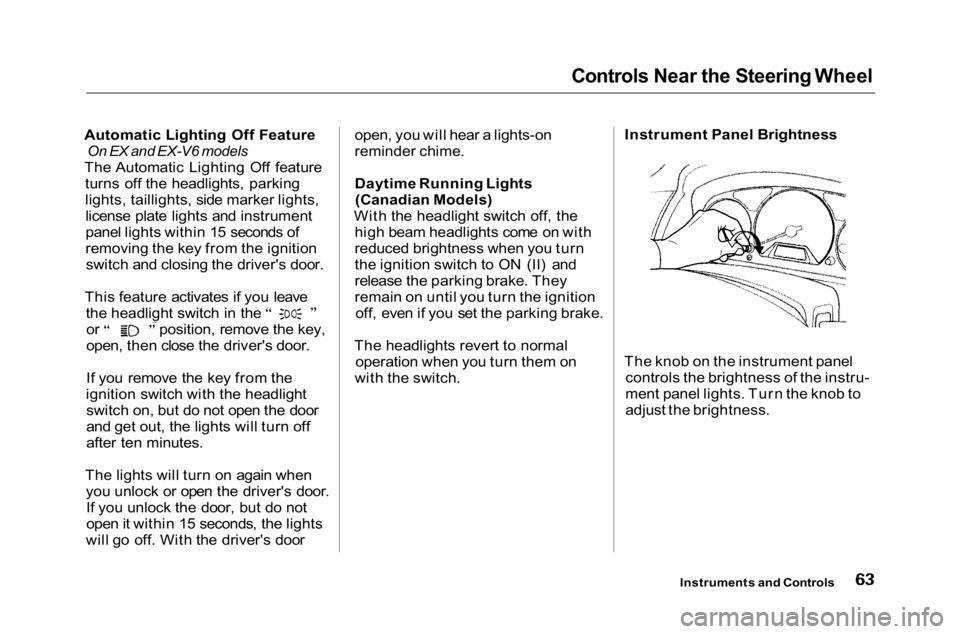
Controls Near the Steering Wheel
Automatic Lighting Off Feature
On EX and EX-V6 models
The Automatic Lighting Off feature turns off the headlights, parking
lights, taillights, side marker lights,license plate lights and instrument
panel lights within 15 seconds of
removing the key from the ignitionswitch and closing the driver's door.
This feature activates if you leave the headlight switch in the
or position, remove the key,
open, then close the driver's door.
If you remove the key from the
ignition switch with the headlight switch on, but do not open the door
and get out, the lights will turn off
after ten minutes.
The lights will turn on again when you unlock or open the driver's door.If you unlock the door, but do not
open it within 15 seconds, the lights
will go off. With the driver's door open, you will hear a lights-on
reminder chime.
Daytime Running Lights
(Canadian Models)
With the headlight switch off, the high beam headlights come on with
reduced brightness when you turn
the ignition switch to ON (II) and
release the parking brake. They
remain on until you turn the ignitionoff, even if you set the parking brake.
The headlights revert to normal operation when you turn them on
with the switch. Instrument Panel Brightness
The knob on the instrument panel controls the brightness of the instru-
ment panel lights. Turn the knob to
adjust the brightness.
Instruments and Controls